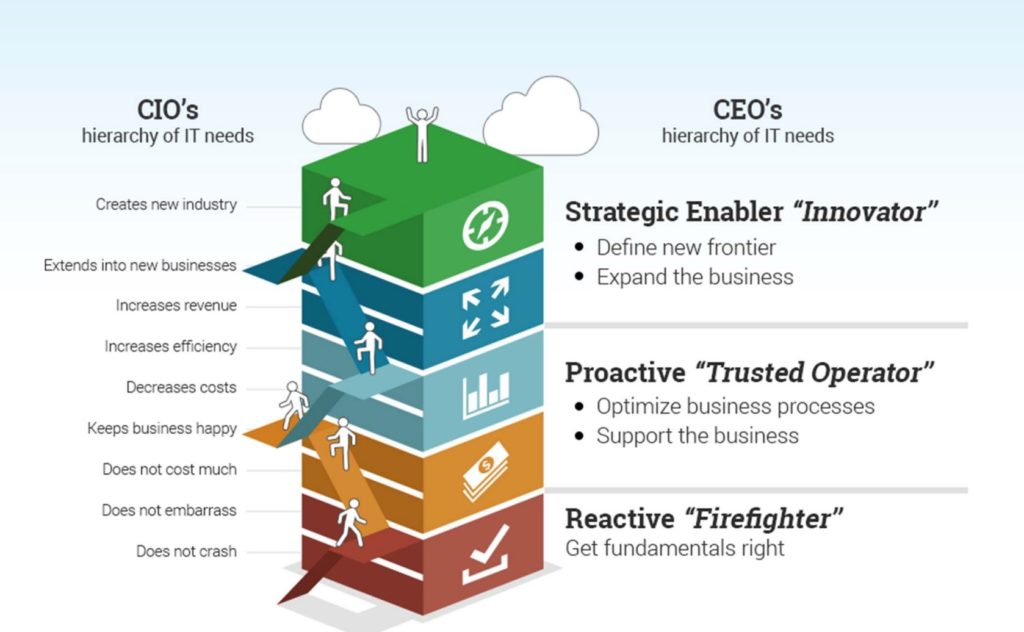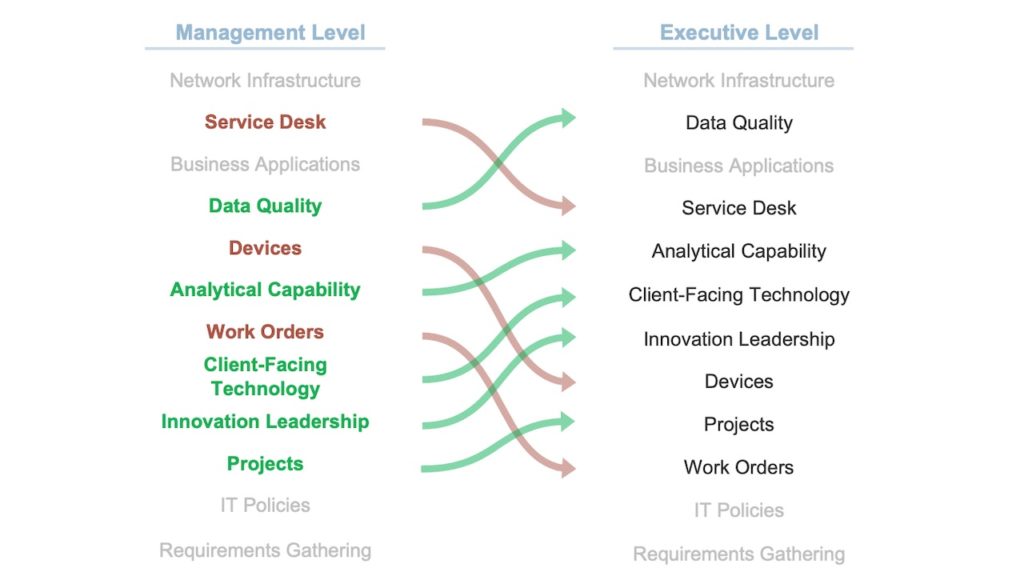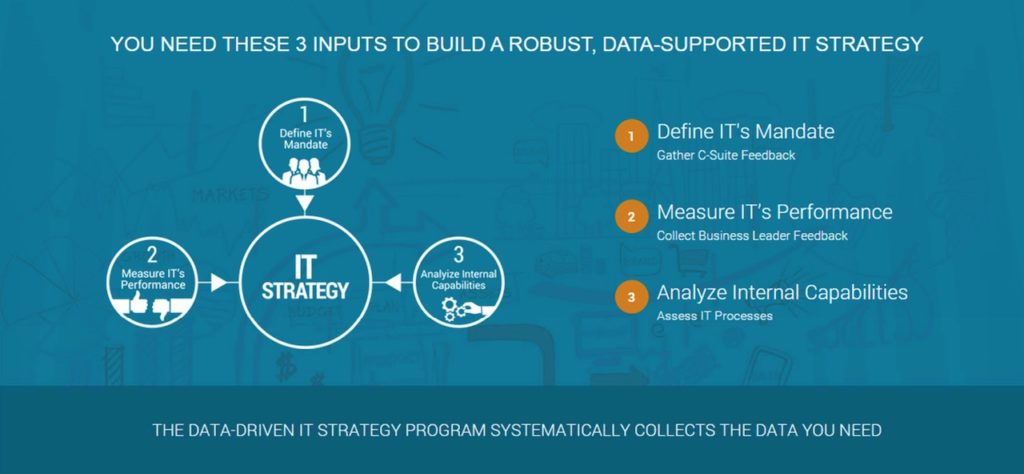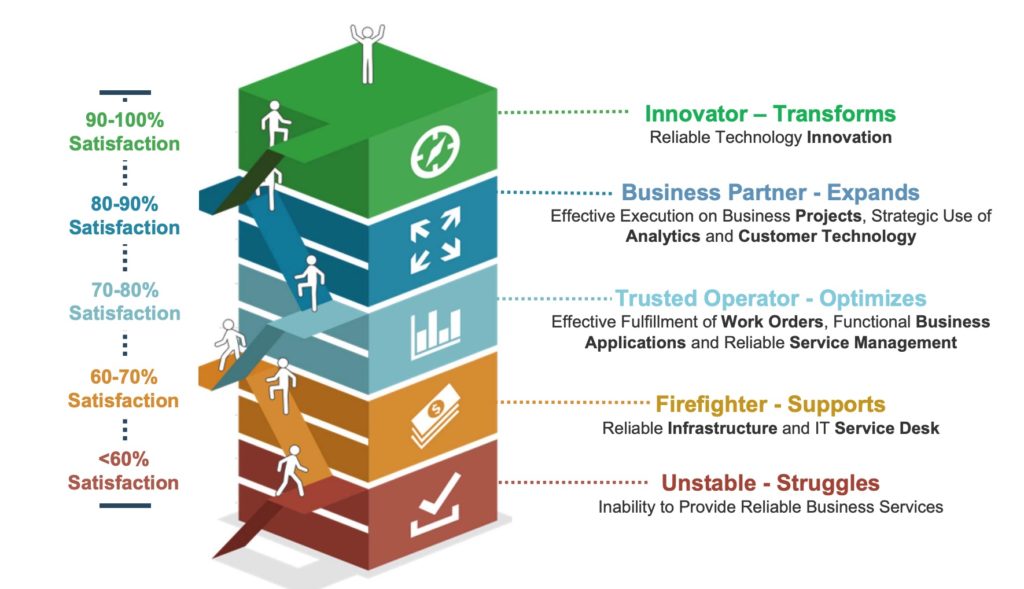IT Maturity: What Type of CIO is Best-Fit?

The search is on for a chief information officer (CIO). Your hiring team isn’t just filling a senior-level role, you’re putting the direction of future IT investments in the hands of the candidate who steps into the role.
Nobody knows the IT “big picture” of your association like the unicorn you select to become your next chief information offer. Point-blank, you cannot afford to make a mistake. You need THE perfect fit.
Mind you, the presumed qualifications of a CIO hopeful skilled at cost containment and running operations on the backend is a far cry from a visionary CIO executive who delivers value-added results that are member-facing.
And yet, many associations haven’t fleshed out the role of IT within the organization today or in the future. Most don't even have a CIO and many have a sole IT director, or IT manager, who wears many hats.
This guide walks through the different types of IT leaders that exist, the essential value differentiators, and the interaction between the stages of organizational maturity.
I’ll detail how executive recruiters, CEOs, and hiring teams can build out your association's ideal CIO hiring profile, narrow down the candidate pool, and make better shortlisting decisions in your CIO executive search.
The Evolving CIO Archetype
The evolution of the CIO from management to a top C-suite executive role has blurred the pathways and typical hiring profiles of CIOs.
The days when a single technician was hired to manage your infrastructure, databases, and email servers are long gone. Since rising through the top-down, "command-and-control" ranks, the modern CIO has adopted a “disrupt or be disrupted” mindset, working cross-functionally as a senior business partner. It's a complete 180% shift in leadership style and skillset.

The same type of pivot is necessary to zone in on the right incoming CIO who will be successful in the role, meeting the needs and strategic vision of your organization at that time.
Operating under the false expectation that the next CIO should be a 'strategic innovator' can put you on the fast track to bill-shock surprises, wasted resources, and unwanted spending. Different organizational maturity stages and projects match different types of CIO competencies and leadership approaches.
Understanding CIO Maturity
The archetype of a CIO falls into broad camps based on the CIO search requirements of CEOs, executive hiring teams, and recruiters. Each symbolizes different stages of organizational maturity and the business hierarchy of IT needs.
As you’re scrolling these different CIO profiles, keep in mind that the title isn’t what’s important. Rather, it’s the business outcomes they bring your organization in terms of driving member value and strategic results.
Also, there are other intermediatory CIO archetypes on the CIO maturity continuum as well that go hand in hand with the spectrum of IT governance and organizational maturity stages. Here are the main ones.
The Modern Transformation CIO
Modern CIOs are IT masterminds and born leaders who have climbed the upward maturity path. A CIO with this high degree of sophistication is in the ideal position to drive innovation processes (aka transform novel ideas into business value) of high-performing organizations.
Beyond bringing ideas to the table for implementation, these “Business Information Stewards” or “IT Thought Brokers” guide continuous process improvement and IT performance measurement.
When launching an executive hiring search for a CIO at this maturity level, look for a business leader first! These contemporary CIOs have three salient personas: communicator, salesperson, and influencer.
Within a mature organization, this high-innovation CIO is the main leadership role driving strategic and business enablement. They spearhead the strategic IT plan and then convey the IT vision to stakeholders and throughout the organization.
The CIO hiring profile for these mature CIOs includes stellar leadership, communication, agility, and other non-technical competencies. Currently, this visionary CIO archetype is focused on seizing opportunities to create more transformative opportunities for the association.
Other nicknames: the business co-creator, change agent, transformer, visionary, trusted business partner, disruptor, strategic enabler, change instigator, business strategists, strategic thinker, and digital innovator.
Read More: Who Should Lead Information Technology? Your 4 Options
Business Partner CIO
IT operations and business services are in the purview of the strategic business partner. This type of CIO is all about the effective delivery of strategic business projects. The primary purpose of these change instigators is to deliver fantastic technology services to members, end-users, and stakeholders.
CIOs who are strategic planners are a good fit if your organization is looking at the big picture, rethinking your current IT services, functions, and road forward.
And they have a bias toward speed. They're able to wire your organization to make decisions faster and be helpful in the long run, connect talent allocation and resources deployment in an end-to-end “people-processes-technology" framework.
These “value strategists” select and roll out technology infrastructure (hardware, software, and other tools) without cost overruns. Everything gets fit together to support seamless internal operations and a frictionless digital journey and member-facing tools .

Quick Note: Many strategic advisors combine the “Transformational CIO” and “Business Partner CIO” maturity levels into one sophisticated CIO profile fit for contemporary business: the Strategic Enabler “Innovator.”
After all, the Transformation CIO is still an integral business partner..and the Business Partner CIO share the same determinants of maturity level as the transformer.
Trusted Operator or Functional CIO
The Trusted CIO Operator is the proactive “head IT guy or gal” focused on IT asset management. They oversee daily IT tactical plans and operational efficiency to maximize end user satisfaction.
This roll-up-your-sleeves type of CIO supports the organization as needed – whether streamlining business processes, supporting staff productivity, or getting projects through the finish line with speed and ease. Instead of taking measured risks to drive strategic valuation, they’re about “doing no harm.”
The focus is on balancing service quality with cost consciousness:
- They have a “get your hands dirty” mindset capable to keep the IT help desk and fulfillment running smoothly and consistently.
- Ensuring timely and effective resolutions of support tickets.
- Optimizing to get things done quickly and easily.
- Tends to maintenance needs of staff workstations and member-facing tools
- Addressing technical debt, legacy systems, and software licensing needs.
They may know what it takes to drive the business forward but are bogged down with the tactics of the day to day to work on long-term value creation. IT service desk takes priority over data quality, new business solutions, and big-impact projects.

Though they're less digital- and innovation-focused than a mature CIO, the functional IT Director still keeps the future vision and technical excellence top of mind.
Other nicknames of the functional CIO include the operations expert, order-taker, functional manager, functional CIO, shepherd of IT.
The Reactive Firefighter or Unstable CIO
This firefighting-type of CIO is at low maturity level in a low-performing organization.
There’s no real IT or Business SMEs (Subject Matter Experts) to dig into the core IT issues. IT is there to keep the lights on, offering little to no real “Business Intelligence” value. These Reactive Firefighters are bogged down fighting the symptoms of service delivery issues instead of addressing the root cause of underlying issues.
In reality, Unstable CIOs mirror today’s low-performing IT manager, service desk leader, or IT admin than an IT leadership role. They're stuck in fight-or-flight mode, trying to find the resources to prevent and/or fix compromised operations, service disruptions, data breaches, or a server glitches.
IT is viewed as a "cost center” that’s a necessary drain on resources. There’s not much tech investment or IT spending power. And what happens when an IT budget is under-funded and under-supported? Often, we see super-low levels of IT sophistication and almost nonexistent business expectations.
In other words, there’s no trust between IT and the business. Basic services aren’t being delivered to end-users and members. And team members stop relying on IT and instead get their own tools, leaving your organization with a ton of shadow IT and all scores of technical debt.
Determining The Right CIO Maturity Level
During your search, look for a CIO candidate who meshes with the challenges, IT team size and structure, culture, priorities, and/or projects at hand. You want to match up required core skillsets to the best-fit type of CIO at that time and next steps in your maturation journey.
Read More: 14 Skills of Successful Association IT Leaders
You want to be thinking about the following questions when building out your ideal hiring profile.
- Which core business goals should IT support best?
- Where is your organization on the upward maturity path? How evolved is your organization?
- Is there a high potential for change? Are you ready to take on the transformational process? Or is there still some resistance to including CIO on the senior leadership team?
- Does your team view the CIO as a business co-creator or closer to a trusted IT admin?
- Are you ready to invest in value-added tech and capabilities? Or, are you drowning in IT costs?
- Are you ready to relentlessly deliver on operational efficiencies and business value? Or, are you still dealing with a room full of servers, loads of technical debt and technology problems?
- Are you somewhere in the middle of the spectrum, between putting out fires and figuring out your reports and decision-making processes?
- Is there a consensus from stakeholders on if and how IT should transform the business?
Step 1 – Consider Your Culture
It all boils down to your digital company culture and organizational structure. Your culture dictates whether IT is seen as roadblocks, risk assessors, or collaborative business co-creator.
Whether you're in the midst of transformation or are stuck with a reactive IT service desk, culture change can help you map the kind of CIO and tech leadership, human capital, and IT capabilities you need to feed value streams and leapfrog towards greater organizational maturity and digital modernization.
It's crucial to roll back on command-and-control traditions and move towards more flexibly in how we deploy cross-functional, high-performing association teams (e.g. RACI model of decision making). This ties in with the importance of culture. Unblocking digital culture change is the most difficult part of any tech leader or officer’s job but it provides an effective framework for your organizational maturity.
Step 2 – Consider IT Strategy
Think about the association IT strategy (if you have one) and the overarching business vision. And then use it to frame your CIO search.
Consider what needs to change in IT to meet your goals. The right CIO maturity level really depends on the shifting C-suite vision and strategic IT plan. If you already have this roadmap planned out, use it to flush out the criteria and essential competencies your organization needs – whether it's an IT thought broker, digital technology leader, both, or neither.
Remember, building a strategy is an ongoing process, not a one-time project. It should be strategic (versus tactical), highlighting the “what's” and “when's” of your priorities rather than the “how’s” of execution.

PRO TIP: Think long-term about your CIO search strategy and leverage your IT strategy framework, if you have one. This way, your CIO talent plan is an actual hiring strategy, rather than a checklist of tactics. Once you onboard a new CIO, they'll take over the succession plan and strategic vision.
Step 3 – Build Consensus with Stakeholders

Talk with the rest of the executive team, senior management, board members, and key business stakeholders to get a full picture of your ideal CIO type, scope, and profile archetype.
It’s vital to gain consensus across the organization on what stakeholders collectively want. What defines the success of your incoming CIO/tech leader? What shared vision will he or she drive forward?
Have an honest strategic conversation about the leadership, organizational and technology priorities that matter most today and going forward. Pursuing "consensus-based decision-making" is the goal here. It eases painstaking CIO headhunting and gives you peace of mind in upcoming hiring decisions. Plus, it helps you ask better CIO interview questions as well.
Discuss the following topics with stakeholders to start building out a CIO selection framework:
- Benchmark your current business maturity.
- Define the next stage of organizational growth and/or maturity.
- Set capability and/or maturity targets.
- Consider the best-match CIO maturity level for your current stage of development.
- Consider the best-match CIO to lead IT and business enablement to the next stage.
You want your incoming CIO to bolster the impact of your mission and build organization-wide agility. And, of course, you want all key players in your organization to be happy with whoever takes on the role.
Read More: Critical Conversations - Starter Topics for Your Strategic Planning Team
Step 4 - Remember, IT Needs and CIO Roles Shift
The latest CIO priorities and IT success metrics change over time. You can’t rest on your laurels on the type of CIO who will join your senior leadership team at any point in time.
Every day, the world around us is changing. So, too, are organizational and market conditions, along with the desires and priorities of your fellow C-suite leaders and board members. And different organizational stages and project phases call for a different type of CIO prowess, and thus a evolving hiring profile.
For instance, let’s consider how different types of CIOs may take on change management.
- The "Transformational CIO" might want to increase experimentation and boldness in business models across the organizational system.
- The "Strategic Business Partner" may be more concerned with enhancing decision-making through the diversity of perspective and style. He or she might engage with the community niche online to build brand awareness, engagement, and legitimacy in the industry.
- The "Trusted Operator" will likely be focused on getting the structures and oversight in place to ensure your change initiatives mitigate risk and achieve intended outcomes.
Read More: Do I need CIO services?
Step 5 - Full-Time CIO vs. Fractional/Virtual CIO
Depending on the required CIO skillsets, time, and budget, you may be better off sourcing CIO expertise on a part-time or temporary basis. Compared to hiring a full-time CIO as an “in-house” employee of your association, a fractional or virtual CIO works with your organization on contract.
Part-time virtual CIO consultants still sit at the executive planning table but you're not paying them to work full time. You generally save significant money outsourcing CIO services to a fractional CIO strategic/transformation advisor over hiring a full-time, in-house CIO.
Step 6 - Frame Your CIO Search
Now it’s time to build your organization’s CIO hiring profile and/or IT leadership persona to hand off to your resume reviewer, executive hiring teams, CIO scouts, and leadership recruiters.
Again, when thinking about the ideal level of IT sophistication, consider where your organization is on the pathway to becoming a high-performer. Ask the right question to ensure your incoming CIO supports business priorities, stakeholder needs, and strategy gaps.
Read More: 18 CIO Interview Questions
A disconnect between the CIO and other senior leadership is a much too common reason for failure. Your soon-to-be CIO must be able to bridge this chasm.
For instance, there is a winning formula you can use to identify a candidate who has succeeded in this type of role previously. Mature CIO candidates have these 4 essential ingredients on their resume/CV:
- Has worked with C-suite leaders and executive teams to create the vision for transformation.
- Builds digital discipline across the entire organization, beyond just IT.
- Getting the most value in terms of productivity and efficiency as possible.
- Hyper-focused on member/customer engagement.
Example Scenario - Hiring a Functional CIO to Keep IT Costs Down
If you’re looking to run your IT ops in the most cost-effective way possible, the functional CIO may be your best bet.
Functional CIOs mainly contribute economic value to the business:
- Conserving IT resources like cutting operational costs and reducing price-to-performance ratios.
- Averting risks, service disruptions, and delayed ticket responses.
- Getting IT to work fast, stay compliant, and visibly uphold shared organizational goals and defined accountabilities.
Today, these operational and “IT liaison” responsibilities are typically handled by an "IT Director" level position. Regardless, go with a functional IT leader if you need someone to manage IT assets to realize intended benefits, hit budget targets, and stay on track with operating plans.
Example Scenario - Hire a Business Partner to Expand the Strategic Use of IT
The evolved, forward-gazing type of CIO is the business co-creator and trusted value driver.
These disruptive CIOs are focused on the future vision. They tend to have a stronger appetite for transformational IT than other types of CIOs, technology leaders, digital innovation officers, and even most CEOs.
In record time – and with a high degree of success – these movers-and-shakers can roll out business continuity plans, map value streams, and craft a communication plan for IT projects.
They work elegantly and cohesively to reconcile the seemingly conflicting needs of driving strategic focus simultaneously with organizational dexterity. They're able to rally the troops throughout your organization, including strategic vendor partners, like its second nature. And in doing so, these CIO strategists gain buy-in from key stakeholders and get decision-makers to commit resources towards IT recommendations.
Executive-level CIOs typically value integrated analytical capability; indicators and dimensions of data quality; and user-centricity more than IT managers, IT directors, trusted CIO operators, and service desk firefighters. These forward-thinking transformers are destined to be the king of your member data. They prioritize the need to institutionalize your data governance framework, while simultaneously increasing the transparency and efficiency of your association’s privacy culture and digital trust.
Example Scenario - Hire a Visionary CIO to Prove the Value of IT Investment
Some folks consider the “Visionary CIO” to be a subtype of the “Transformation CIO”. Truth is, in the age of digital disruption, transformation is innovation.
Both so-called visionary CIOs and transformational CIOs have similar clout and capabilities. They know how to deploy, manage, and adapt people, processes, and technology to empower coherent, data-driven decision-making that drives business value and non-dues revenue. And they’re laser-focused on innovation, IT excellence, and distinct digital culture change.
More agile, CIOs and IT departments actually score radically higher on measures of satisfaction across the nine core competencies of healthy IT. The Strategic Enabler “Innovator" scores the best on business performance, followed by the Proactive "Trusted Operator,” and so forth. But, of course, culture-fit is key here.
Wrap Up – Which Level of CIO Maturity is Best for You?
Regardless of the size or mission of your association, you need a CIO-type inspirational leader that is able to follow a systematic, data-driven process to lead the organization through digital transformation.
The chief information officer job title is used synonymously (and often incorrectly) with the chief transformation officer, chief digital officer, and chief digital transformation officer – though they’re all business-minded salespeople using tech to enable the business.
Culture determines whether your association is ready to hire an innovative CIO executive and/or a Trusted Operator – or if you really need a multifunctional digital strategist to wear multiple hats.
The quality and cohesion of your organization’s processes, technology, and IT department depend on the strong leadership and direction of the CIO you hire. This decision can be the difference between driving top-line growth and organizational maturity and falling short on vital change initiatives to attract new members.
Need help identifying, assessing, or defining your IT organizational structure and the best type of CIO or technology leadership to drive effectiveness?
Let’s talk! We can help you along your path to CIO and IT organizational maturity!
Here are some other resources on IT leadership articles to help as well:



